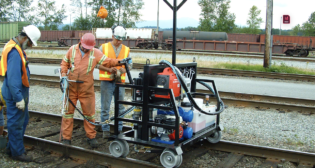
Precision Placement
Written by William C. Vantuono, Editor-in-ChiefGREX
Georgetown Rail Equipment Company’s ballast distribution technology employs three primary components. The first is mechanical delivery, which is comprised of the physical components that provide the means for dumping ballast. The second is quantification and placement. The final component is GateSync®, which connects the mechanical delivery mechanism to the “on the ground” ballast requirements. GateSync® takes the survey data produced from BallastSaver® and uses it to perform ballast delivery with integrated Solaris® kits. Lynn Turner, vice president marketing and sales at GREX, says these synchronized technologies provide a total solution in ballast delivery by achieiving maximum accuracy and high-speed performance.
The mechanical aspect is comprised of Solaris® kits, which convert a manually operated ballast car into a powered solution with hydraulically controlled ballast gates and self-contained power. “With far more than 1,000 Solaris® kits in service, they have proven to be highly reliable,” said Turner.
BallastSaver® acts as the eyes of the GREX solution, utilizing the latest LIDAR technology to measure and record the ballast profile. Since each railroad has its own ideal profile for ballast cross-section, BallastSaver® utilizes each customer’s accepted standard profile to calculate ballast deficiencies. Turner says this allows BallastSaver® to consistently inspect the track bed with the same customer-defined criteria mile after mile, providing railroads an unbiased inspection across their territory and eliminating human interjection.
“A BallastSaver® inspection reduces the possibility of delivering excess ballast by more accurately directing ballast exactly where it is needed most,” said Turner. “Extensive repeatability tests have been performed at TTCI to validate and ensure that BallastSaver® continues to offer the most efficient and accurate means of assessing ballast profiles.”
GateSync® functions as the brain of the solution by taking the precise location and amount of ballast needed, which is provided by BallastSaver®, and executing a ballast delivery unloading using Solaris® equipped ballast cars. Turner says GateSync® continues to see software changes and improvements that enhance its ability to deliver the best results possible and mentions that the improvements realized for BallastSaver® have also benefited GateSync’s performance, providing customers with the most efficient ballast delivery process in the industry.
“These combined technologies provide a state-of-the-art ballast delivery solution with industry leading efficiency and safety,” said Turner. “GREX is committed to continued refinement and support of these technologies to maintain state-of-the-art industry position. With Solaris®, BallastSaver®, and GateSync® in combination, GREX offers a complete ballast delivery solution that can accurately define the volume of ballast needed, the location where it should be placed, and can execute an efficient and exact unloading.”
HRSI
Herzog Railroad Services Inc. (HRSI) is now integrating its new P.L.U.S./SMART Inertial System into its Programmable Linear Unloading System (P.L.U.S.) and SMART Train fleet. The Inertial System is a decade-long R&D effort that provides a backup to GPS-guided ballast unloading by allowing precise ballast distribution in areas that are prone to GPS outages, such as tunnels and mountainous areas.
HRSI notes that pre-dump surveys, which are performed prior to ballast distribution to confirm the position of switches, crossings, and other fixed locations, can be challenging during surveys, in areas where GPS outages occur. That challenge remains when the train arrives to dump the ballast.
According to HRSI, some areas could take longer than others to complete a thorough survey due to a weak or complete lack of GPS signal. The company says the new system drastically reduces the survey time while dramatically improving the accuracy of both the survey and the ballast dump. HRSI’s new system uses GPS and a variety of other sensors to maintain accuracy in areas of poor GPS.
“GPS outages will no longer be a concern when dumping ballast, and the same can be said of the pre-dump survey when utilizing the Herzog ProScan LIDAR Truck to replace the manual survey,” said Tim Francis, HRSI vice president of marketing.
Miner
Miner Enterprises Inc. AggreGate ballast discharge outlets are available in manual, air-operated, electric, or remote control models. The company says the system provides a safe, durable, and maintenance-free ballast discharge system that can be easily applied to new or existing cars. The AggreGate’s design features, such as the large guillotine door openings designed to stop ballast flow with minimum effort, easy-to-operate toggle-type linkage systems and tapered doors for easy ballast shutoff at switches, crossovers, and bridges, allow it to effectively deliver ballast inside, outside, or to both sides of the rail simultaneously.
“Miner is always working on continuous improvement projects with the railroads and track crews to improve ballast unloading and efficiency,” the company said.
Plasser American
Plasser American Corp. says that only with sufficient ballast can tracks be correctly maintained and adequately tamped. Plasser has developed two tools: a ballast profile measuring system and a ballast distribution system.
Plasser has developed a ballast measuring system based on data recorded by a high-speed 360-degree clearance scanner. The scanner, installed on one end of a measuring vehicle, records crosscuts of the track and its surroundings up to 200 times per second with up to 10,000 measurements per crosscut. The data recorded by the system are primarily used for clearance evaluation, but are also suited for obtaining information about the state of the ballast and its distribution.
The ballast measuring system analyzes the recorded data against three user-definable ballast profiles simultaneously to obtain accurate information about areas with ballast excess or deficit. The data recorded by the system is then used to guide ballast dump trains.
Plasser’s Ballast Distribution System is performed as a “one pass” operation and consists of two units that can either work completely independent of one another or together as one machine. The BDS-100 is equipped with a hopper, for ballast storage, four conveyors, for ballast distribution, and Plasser’s well-proven shoulder and X-type plows, for ballast profiling. The BDS-200 is equipped with two ballast brooms. The “pick-up” broom sweeps the excess ballast from the track onto a conveyor, which loads the ballast into the BDS 100 or into a Plasser MFS-type Conveyor and Hopper Car. The “finishing” broom provides the final track dressing. The ballast handling capacity of the Plasser Ballast Distribution System can be increased by coupling Plasser MFS-type Conveyor and Hopper Cars between the two units.
The BDS 100/200 can accompany high-speed 09-3X tampers for final track dressing or work as an independent machine to distribute ballast. When working as an independent machine it may be used to pick up excess ballast from the track shoulders for distribution at any location, including switches.



